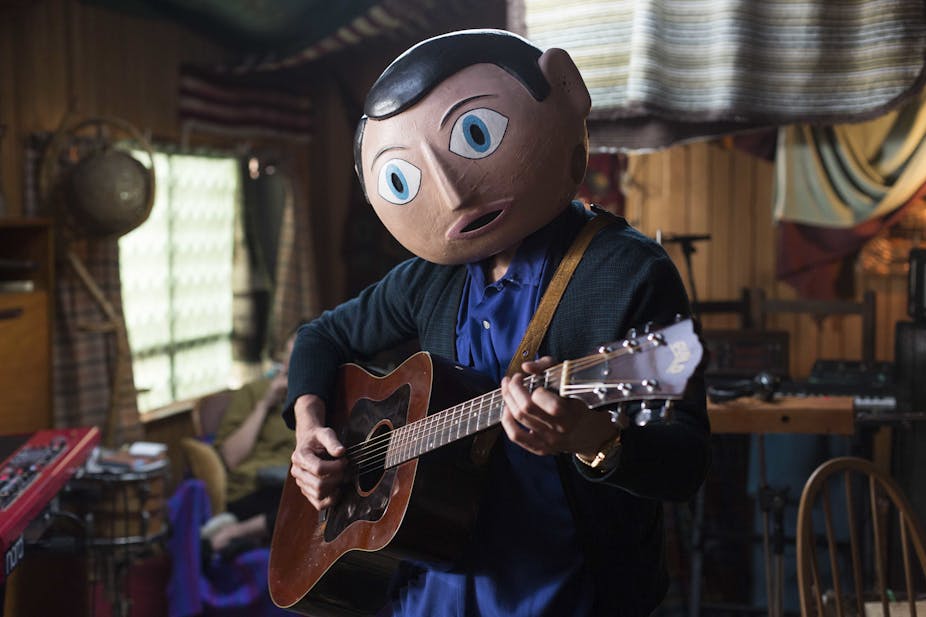The run up to the release of Lenny Abrahamson’s latest film, Frank, was characterised by a certain amount of perplexity. Unsurprising, given the posters emblazoned with that enormous papier-mâché mask and (apparently) starring Michael Fassbender.
Frank is the tale of budding keyboardist Jon Burroughs (played by Domhnall Gleeson) and his membership of a truly bizarre band, whose oeuvre could best be labelled “experimental” or “alternative”. The film follows his attempts to unravel what it is his bandmates want from him and his music. This all takes place against an atmosphere of collective mental instability, ranging from the wonderfully entertaining to the deeply and increasingly disturbing.
At the heart of the creativity is the worshipped frontman – Frank (Michael Fassbender) – whose musical and lyrical talents are celebrated by Jon’s fellow musicians, but who is perhaps most notable for permanently sporting that enormous fake head.
Before we go any further, I should start by clearing up a crucial point: this film is not (and is not really trying to be) about the disconcerting musical comedy of Frank Sidebottom, alter ego of the late Chris Sievey. Yes, the eponymous hero appears in an enormous papier-mâché head (very similar to Sidebottom’s) for almost the entire film and, yes, he is a singer and musician.
But that is the full extent of the similarity between the film’s character and the “original”, at least to most audiences (it is possible that other more subtle connections may be discernable for those who knew Sievey personally). So given the limited presence of anything else Sidebottom-esque in Fassbender’s Frank, the final link is perhaps the most surprising: the film was co-written by Sievey’s keyboard player, Jon Ronson.

A couple of crucial differences between Sidebottom and this Frank are worthy of particular note. Most obvious is voice. Fassbender’s smooth, cool American accent is the culturally diametric opposite of Sidebottom’s nasal Mancunian “club singer” delivery. Where a character’s face is totally obscured – to the extent that he is required to describe his facial expressions in amusingly intricate detail – voice really matters. So Fassbender’s warm, attractive, calm delivery makes for a very different character to Sievey’s original.
A second key difference is the story itself. The film’s wobbly-headed hero is at the heart of the experimental creation of self-consciously new music. Sidebottom, by contrast, was best known for generating incongruity-induced laughs by juxtaposing his Northern, unrefined shouty-singing and cheap-synth backing with well-known hits (his inimitable cover of Joy Division’s Love Will Tear Us Apart sticks in the mind).
The extent of the divergence between the “original Frank” and this reimagining is certainly beneficial for reaching an audience beyond the relatively small number of Sidebottom devotees. Since the film is not really about Sidebottom, no prior knowledge of that character is required to enjoy this highly entertaining movie.
The nature of the divergence means that Fassbender’s Frank is not, in and of himself, a comedic character. Even before his mental fragility is fully revealed, Frank is not really designed to make audiences laugh. He does provide a number of very amusing moments – his “most likable song ever” is a tragically brief glimmer of nuanced comic genius which will surely make an appearance in my future lectures on music and comedy. But this Frank is not inherently funny. And, as hinted above, his mental illness becomes the central focus of the film’s second half, turning the story into an exploration of issues that don’t typically generate laughs.

At its core the film is about music and the idea of authenticity. It’s worth remembering that “authenticity” isn’t a real thing – an actual quality – but rather a constructed idea. It is a belief system commonly invoked for judging the value of things, especially music.
And this film is all about celebrating the intangible qualities of innate talent that most commonly signpost “authentic” music. The musical quality and skill set that is lauded by Frank’s disciples (and frantically but unsuccessfully sought by Jon) is – much like Frank’s face – deliberately mystified, veiled, and inscrutable.
As this might imply, although there are moments where we are led to expect that Jon’s journey is one of discovery, his only discovery is that he’ll never have “it”. So the narrative appears to trot out the tired cliché that true creativity can’t be learned.
This celebration of “authenticity” is even symbolised in the technology, something I find a little tiring. The film begins with Jon failing to come up with an original song while recording his attempts on digital home studio gear. And creative idyll is later represented by the analogue synths and theremin of his bandmates, the reel-to-reel tape of the ramshackle studio. On top of all this, the role of social media in the ultimate demise of the band adds to this bleak picture of the artificial, modern world.
More specifically, the film reeks of investment in Western society’s fantasy of the “troubled genius” musician. This is a stereotype that, while strangely compelling, isn’t really born out in the reality of most successful, working musicians.
I’m afraid I found some of these themes and judgements just a little too hackneyed and simplistic.
In the end, Frank is a film about pushing the boundaries. The irony is that such a trope is not all that original in film. Nor is it ground-breaking in music – the recording of “found sounds” as creative process, for instance, is presented here as envelope-pushing stuff, but has in fact been done by bands for more than 50 years.
That said, I’d encourage seeing it. Maybe the film’s use of stereotype gets under my skin a little, something that is amplified having worked in an experimental studio myself. But it is enjoyable nevertheless, and nicely multidimensional, although we may not grow to love the characters as it would appear we are meant to.

